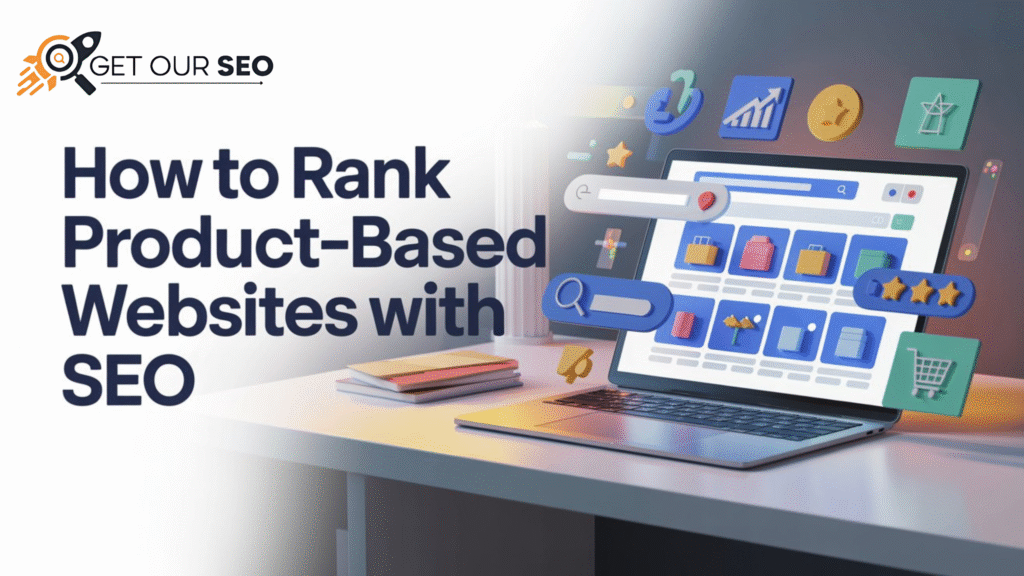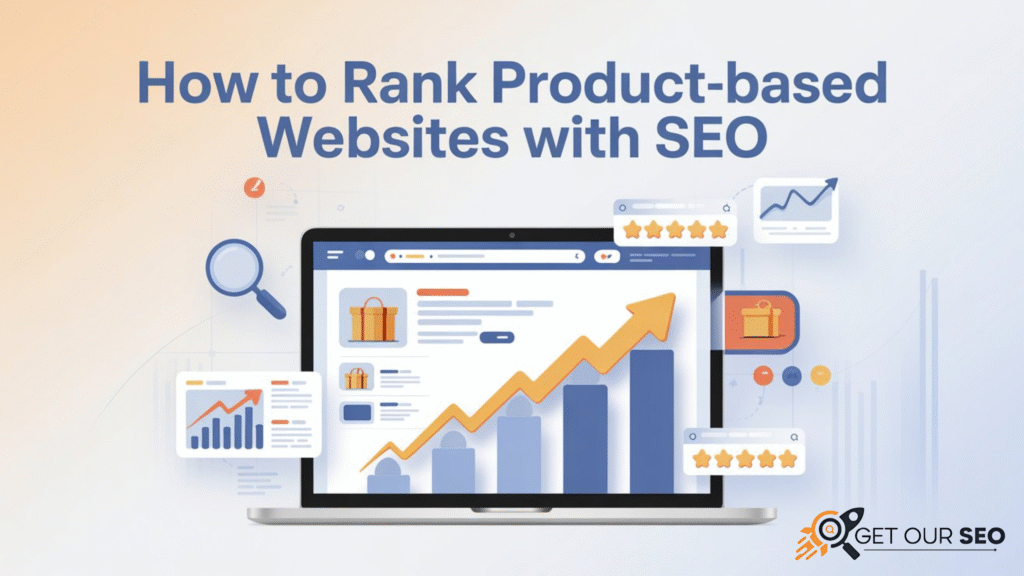Ranking a product-based website requires a multifaceted SEO approach that combines technical excellence, compelling content, and strategic optimization. Search engines prioritize sites that deliver exceptional user experiences while making it easy for crawlers to understand and index product information. This comprehensive guide walks you through proven strategies to elevate your e-commerce store’s search visibility and drive sustainable organic traffic.
Understanding E-commerce SEO Fundamentals
E-commerce SEO involves optimizing various elements, including content, meta details, URL structure, site architecture, and internal linking to help search engines discover, crawl, and rank your product pages. Unlike traditional SEO that might focus solely on blog content, product-based SEO must balance commercial intent with informational value while addressing duplicate content challenges inherent to online stores.

The foundation of successful product page optimization rests on three pillars: technical infrastructure that enables efficient crawling and indexing, on-page optimization that targets buyer intent, and authority-building through quality backlinks and user signals. When executed properly, these elements work synergistically to improve rankings, increase organic traffic, and ultimately boost conversions.
Conducting Strategic Keyword Research
Target Product-Specific and Long-Tail Keywords
Keyword research forms the foundation of your e-commerce SEO strategy. Instead of competing for broad, highly competitive terms like “running shoes,” target specific long-tail variations such as “waterproof trail running shoes for wide feet”. These longer, more descriptive phrases have lower competition, higher conversion rates, and better align with how actual customers search.
Use keyword research tools like Google Keyword Planner, Ahrefs, SEMrush, or Ubersuggest to identify primary keywords (exact product names and features) and secondary keywords (related terms and use cases). Think like your customers—what would they type into Google when searching for your products?
Analyze Search Intent
Understanding search intent is crucial for matching content to user needs. Break down keyword intent by analyzing search engine results pages (SERPs), looking at Google ads for commercial intent, and reviewing your analytics for content with high bounce rates that may not match search intent. Target different keywords for different stages of the buyer journey: informational keywords for awareness, comparison keywords for consideration, and transactional keywords for decision-making.
Map Keywords Strategically
Create a comprehensive keyword map that prevents cannibalization while maximizing coverage. Assign one primary keyword and a few ancillary keywords for your top 50-100 pages, including product pages, category pages, and blog posts. Each page should target distinct but related query sets that collectively strengthen your topical authority.

Optimizing Product Pages for Maximum Visibility
Craft Compelling Title Tags and Meta Descriptions
Title tags are among the most important on-page SEO elements. Include your primary keyword naturally within the first 60 characters while making titles click-worthy. For example, instead of “Blue Widget,” use “Premium Blue Widget – Durable, Waterproof Design | [Brand Name].”
Meta descriptions, while not direct ranking factors, significantly impact click-through rates. Write compelling 150-160 character descriptions that incorporate keywords naturally and highlight your unique value proposition. Think of meta descriptions as your sales pitch in search results.
Write Unique, Benefit-Focused Product Descriptions
One of the most overlooked ecommerce SEO strategies is writing unique product descriptions. Avoid copying manufacturer descriptions, as this creates duplicate content across dozens of sites. Instead, create original, compelling descriptions that highlight benefits rather than just listing features.
For example, instead of writing “This phone case is made of silicone,” write “This soft silicone case protects your phone from drops while offering a comfortable, non-slip grip”. Focus on answering customer questions, addressing pain points, and explaining how the product improves their lives.
Structure descriptions for easy scanning using short paragraphs, bullet points, and descriptive subheadings. Place target keywords naturally within the first 100 words, title tags, headings, and throughout the description without keyword stuffing.
Optimize Product URLs
Use descriptive, keyword-rich URLs that clearly indicate page content. Instead of generic URLs like “yoursite.com/product/12345,” use “yoursite.com/red-running-shoes-women” to provide context for both users and search engines. Keep URLs concise, use hyphens to separate words (not underscores), and avoid unnecessary parameters.
Implement High-Quality Images with Proper Optimization
Visual content is crucial for product pages, but images must be optimized for both user experience and SEO. Use descriptive, keyword-rich file names like “blue-cashmere-sweater.jpg” instead of “IMG001.jpg”. This helps search engines understand image content and improves chances of appearing in image search results.
Add descriptive alt text to every product image, incorporating relevant keywords naturally while accurately describing what the image shows. Alt text serves dual purposes: it improves accessibility for visually impaired users and provides context for search engine crawlers.
Compress images to keep file sizes under 70KB without sacrificing quality, as page load speed directly impacts rankings. Use JPEG format for most product images as it offers the best balance between quality and file size. Consider implementing next-generation formats like WebP for even better compression.
Add Structured Data and Schema Markup
Schema markup is structured data code that helps search engines better understand your product pages. By implementing product schema using JSON-LD format, you can enable rich snippets that display star ratings, prices, availability, and other product details directly in search results.
Essential schema properties include product name, image, description, brand, SKU, price, currency, availability, and review ratings. Adding this structured data can significantly increase click-through rates by making your listings more prominent and informative in search results.
Use Google’s Rich Results Test or Schema Markup Validator to verify your implementation is correct. Regularly update schema markup to ensure pricing, stock status, and other product details remain accurate.
Incorporate User-Generated Content
Customer reviews and user-generated content (UGC) provide fresh, keyword-rich content while building trust. Display reviews prominently on product pages with star ratings, customer photos, and detailed feedback. Research shows that 79% of consumers rely on user reviews before purchasing, and sites featuring customer images see significantly higher conversion rates.
Encourage customers to submit reviews, photos, and videos of products in use. This authentic content not only improves SEO by adding unique, regularly updated content but also serves as powerful social proof that influences purchase decisions.
Implement review schema markup to display star ratings in search results, which can dramatically improve click-through rates. Make reviews searchable and pin the best ones at the top to maximize their impact.
Create Comprehensive FAQ Sections
Add FAQ sections to product pages to address common customer questions about sizing, shipping, returns, compatibility, and usage. FAQs serve multiple purposes: they improve user experience, provide additional keyword-rich content, and increase chances of winning featured snippets in search results.
Structure FAQs using question-based formats that mirror natural speech patterns, as this aligns with how people use voice search. Use clear headings and concise answers that directly address the query.
Building a Solid Site Architecture
Follow the Three-Click Rule
Every product on your site should be reachable within three clicks from the homepage. This keeps shoppers from getting frustrated and helps search engines crawl your site more efficiently. Pages buried deeper in your structure are less likely to be indexed and ranked.
Create a clear hierarchical structure: Homepage → Category → Subcategory → Product. For example, a clothing store might structure pages as: Homepage → Men’s Clothing → Shirts → Formal White Shirt.
Optimize Category and Collection Pages
Category pages organize and showcase groups of related products, making them critical for both user experience and SEO. Optimize category pages with unique descriptions, relevant keywords in titles and headings, high-quality images, and clear navigation with filtering options.
Add 100-300 words of keyword-optimized descriptive text to category pages, placing it above the fold when possible. This helps search engines understand the page topic while providing value to visitors. Use breadcrumb navigation to show hierarchy and improve crawlability.
Implement Strong Internal Linking
Internal linking guides users and search engines through your website, distributing page authority and establishing content relationships. Link related products, categories, and blog content to each other using descriptive anchor text.

Best practices include linking from high-authority pages to important product pages, using keyword-rich anchor text naturally, and ensuring every page can be reached through internal links. A strong internal linking structure keeps visitors engaged and helps search engines understand your website better.
Create and Submit XML Sitemaps
Regularly update XML sitemaps for product, category, and content pages so search engines can index them quickly. Submit sitemaps to Google Search Console to ensure efficient crawling. For large ecommerce sites with thousands of URLs, use robots.txt, canonical tags, and noindex attributes to guide crawlers toward your most valuable pages.
Addressing Technical SEO Essentials
Improve Page Speed and Core Web Vitals
Website speed is a critical ranking factor affecting both user experience and SEO. Slow websites lead to higher bounce rates and lower rankings. Optimize page speed by compressing images, enabling browser caching, minimizing CSS and JavaScript, and using a Content Delivery Network (CDN).
Aim for load times under 3 seconds, as even a 1-second delay can reduce conversions by up to 7%. Focus on Core Web Vitals metrics, including Largest Contentful Paint (LCP), First Input Delay (FID), and Cumulative Layout Shift (CLS), as these directly impact rankings and user experience.
Ensure Mobile-Friendliness
With over 60% of searches coming from mobile devices, mobile optimization is essential. Implement a responsive web design that adapts seamlessly to different screen sizes. Use Google’s Mobile-Friendly Test to identify and fix mobile usability issues.
Optimize mobile navigation with sticky menus, collapsible sections, and large-enough CTAs. Place tappable elements within easy reach of users’ thumbs in the lower half of the screen. A fast, responsive mobile site ensures visitors stay longer and navigate easily.
Implement HTTPS Across Your Site
HTTPS is a confirmed ranking factor and essential for user trust and data security. Ensure all pages use HTTPS, not just the homepage or checkout pages. Use 301 redirects to send all HTTP traffic to HTTPS versions, and verify there are no mixed content issues.
Manage Duplicate Content
Duplicate content is one of the most common issues affecting e-commerce SEO. When search engines find multiple versions of identical content, they struggle to determine which version to rank, diluting your SEO efforts.
Common causes include product variations, manufacturer descriptions used across multiple sites, URL parameters, and session IDs. Address duplicate content by implementing canonical tags to indicate preferred page versions, using 301 redirects for permanently moved content, and adding noindex tags to pages you don’t want indexed.
For product variants (different colors, sizes), use canonical tags to point to the main product page. Create unique descriptions for each product rather than recycling manufacturer content.
Optimize Crawl Budget
Large ecommerce sites can overwhelm search engines with thousands of URLs. Optimize crawl budget by using robots.txt to prevent crawling of unimportant pages, implementing canonical tags strategically, and fixing broken links that waste crawl resources.
Creating Content That Ranks and Converts
Develop Content Marketing Strategy
Beyond product pages, create valuable content that attracts customers at different stages of the buying journey. Publish product guides, comparison articles, how-to content, and industry insights that target informational keywords.
For example, if you sell running shoes, create content about marathon training tips, choosing the right running shoes for different foot types, and proper shoe care. Use internal links to connect this content to relevant product and category pages.
Create topic clusters organized around key themes, with supporting posts linking back to central pillar pages. This structure signals expertise to search engines and boosts rankings for competitive terms.
Leverage Blog Content for Long-Tail Keywords
Target long-tail keyword variations through blog articles, product reviews, and educational content. These informational pieces attract traffic from users in the research phase and can be internally linked to commercial pages.
Use blog content to answer common customer questions, address pain points, and provide value beyond product promotion. This builds topical authority and creates natural opportunities for internal linking to product pages.
Building Authority Through Link Building
Implement Strategic Link Building
Quality backlinks from authoritative websites signal to search engines that your site is trustworthy and valuable. For e-commerce sites, effective link-building strategies include guest posting on industry blogs, creating linkable assets like data studies and infographics, pursuing unlinked brand mentions, and developing digital PR campaigns.
Guest posting involves writing articles for relevant websites in your niche, often including backlinks to your site. Instead of only pitching new posts, offer to update existing content, which can be more valuable since those pages may already rank and have backlinks.
Create Linkable Assets
Develop high-value content like comprehensive buying guides, industry research, infographics, and original data studies that naturally attract backlinks. These resources provide value to other websites and publishers who will reference and link to them.
For example, creating “Best Products Under $X” guides or comprehensive comparison resources can earn links from bloggers, journalists, and industry websites. Promote these assets through outreach to relevant publications and influencers.
Pursue Local and Industry-Specific Links
For businesses targeting specific regions, focus on building local backlinks from regional publications, local business directories, event sponsorships, and partnerships with local organizations. These location-specific backlinks signal relevance to search engines for geo-targeted queries.
Collaborate with complementary businesses in your industry for mutual backlinking opportunities. For instance, if you sell fitness gear, partner with nutrition brands, gyms, or wellness studios for cross-promotions.
Develop Affiliate Partnerships
Affiliate programs generate both sales and quality backlinks from partner websites promoting your products. When affiliates create content featuring your products, they typically link back to your product pages, building authority while driving referral traffic.
Optimizing for AI and Voice Search
Prepare for AI-Powered Search
As search evolves toward Answer Engine Optimization (AEO) and Generative Engine Optimization (GEO), product pages must contain comprehensive, context-rich information that AI models can easily parse and understand. Structure content to answer likely user questions through FAQs, detailed descriptions, and multimedia integrations.
Implement semantic SEO that emphasizes context over isolated keywords. Create topic clusters linking related products, blog posts, and guides to build cohesive knowledge structures recognized by AI crawlers. Use natural language that mirrors how customers speak and write conversationally.
Optimize for Voice Search Queries
Voice search is projected to surpass $45 billion in sales by 2025, making optimization essential for e-commerce success. Voice queries are longer and more conversational than typed searches—instead of “running shoes,” voice users ask “What are the best running shoes for men under $150?”
Focus on natural language, conversational keywords, and long-tail phrases that reflect how people actually speak. Incorporate location-based keywords for “near me” queries, as voice search is heavily tied to local intent. Optimize content for featured snippets, as voice assistants often read these aloud when responding to queries.
Create FAQ sections with questions and answers in natural language, as this format aligns perfectly with voice search patterns. Ensure your site loads quickly on mobile devices, as over 50% of voice searches happen on mobile.
Implement Conversational Content
Write content that sounds like a friendly conversation rather than technical documentation. Use question-based formats, avoid complex jargon, and simulate natural speech patterns. This approach satisfies both voice search optimization and Google’s preference for helpful, natural content.
Monitoring Performance and Continuous Optimization
Track Key SEO Metrics
Use Google Search Console to monitor indexation, identify crawl errors, and track search performance. Analyze which keywords drive traffic, which pages rank highest, and where opportunities exist for improvement.
Monitor Core Web Vitals, page speed, mobile usability, and structured data implementation. Regularly audit your site using tools like Screaming Frog SEO Spider, Ahrefs, or SEMrush to identify technical issues, broken links, and optimization opportunities.
Analyze User Experience Signals
User experience signals like dwell time, bounce rate, and click-through rate provide valuable insights into how well your content satisfies visitor needs. Longer sessions, lower bounce rates, and higher engagement signal to search engines that your site provides value.
Improving UX elements like site navigation, content readability, page load speed, and mobile responsiveness enhances both user satisfaction and SEO performance. When users have positive experiences, they’re more likely to return, share content, and convert—all favorable factors for rankings.

Conduct Regular SEO Audits
Schedule comprehensive technical SEO audits to identify and address issues before they impact rankings. Audit site structure, mobile-friendliness, page speed, indexation, duplicate content, internal and external linking, and security protocols.
Review on-page SEO elements, including titles, headings, meta descriptions, and images with relevant keywords. Analyze content quality, identifying thin or duplicate content that needs improvement. Check backlink profiles using Ahrefs or SEMrush to review and disavow harmful links.
Leveraging Local SEO for Product-Based Businesses
Even online-only businesses can benefit from local SEO strategies by targeting specific geographic markets where they see traction or growth potential. Local SEO helps you appear in location-based searches like “best in [location]” or “ near me”.
Optimize for Local Keywords
Incorporate location-specific keywords in product descriptions, meta tags, headers, and content. For example, optimize for “soy candles in Austin” to appear when Austin-area users search for “soy candles” or “soy candles near me”.
Create Location-Specific Landing Pages
Develop dedicated landing pages tailored to specific cities or regions, incorporating local keywords, region-specific offers, and customer testimonials from those areas. These pages help rank for geo-related searches while providing personalized experiences that build trust.
Build Local Backlinks
Focus on earning links from credible, location-specific sources like regional publications, local directories, event sponsorships, and partnerships with local organizations. These backlinks signal geographic relevance to search engines, boosting authority in targeted areas.
Conversion Rate Optimization
While SEO brings traffic to your site, conversion rate optimization (CRO) ensures visitors become customers. Optimize product pages with high-quality images and videos, clear calls-to-action, trust signals like security badges and guarantees, and streamlined checkout processes.
Use strategic discounts, free shipping thresholds, and loyalty programs to incentivize purchases. Implement one-click checkout for returning customers, offer multiple payment options including digital wallets, and pre-fill promo codes to reduce friction.
Display social proof through customer reviews, testimonials, and “frequently bought together” recommendations. Personalize product recommendations based on browsing history and preferences. Create urgency with limited-time offers and stock scarcity notifications.
Conclusion
Ranking a product-based website with SEO requires a holistic approach combining technical excellence, strategic content creation, and continuous optimization. Start with comprehensive keyword research targeting long-tail, buyer-intent keywords. Optimize every product page with unique descriptions, compelling titles, structured data, and high-quality images. Build a logical site architecture with clear navigation and strong internal linking.
Address technical fundamentals, including page speed, mobile-friendliness, HTTPS implementation, and duplicate content management. Create valuable content beyond product pages to attract customers at all stages of the buying journey. Build authority through strategic link building and develop partnerships that generate quality backlinks.
Prepare for the future by optimizing for AI-powered search and voice queries using conversational, natural language content. Monitor performance continuously using analytics tools, track user experience signals, and conduct regular audits to identify opportunities.
By implementing these proven strategies systematically, you’ll improve search visibility, attract qualified organic traffic, and ultimately increase sales from your product-based website. Remember that SEO is an ongoing process requiring consistent effort, but the long-term benefits of sustainable organic traffic make it one of the most valuable investments for e-commerce success.


